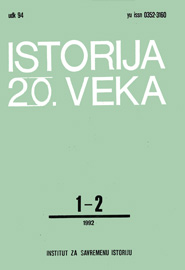JUGOSLAVIJA U PLANOVIMA I PRETENZIJAMA ITALIJANSKE VLADE 1944 - 1945. GODINE
YUGOSLAVIA IN THE PLANS AND ASPIRATIONS OF THE ITALIAN GOVERNMENT 1944 - 1945
Author(s): Enes MilakSubject(s): Diplomatic history, Political history, Recent History (1900 till today), WW II and following years (1940 - 1949), Geopolitics, Wars in Jugoslavia
Published by: Institut za savremenu istoriju, Beograd
Keywords: Yugoslavia; Italian government; plans and aspirations; borders; WWII; postwar period; USSR; Josip Broz Tito; Paris Peace Conference; 1946;
Summary/Abstract: The problem of defining borders between Italy and Yugoslavia after the Second World War is known as the »Trieste issue« and is the topic of this study. Having come out of the war in 1943, Italy began preparing as early as May 1944 to settle the question of borders with Yugoslavia while the war was still going on. Italian diplomats made several efforts towards this end in the course of 1944 and 1945, contacting western Allies in Moscow and the Partisan government of Yugoslavia. Churchill and Wilson accepted Italian demands and promised Italy an eastern border corresponding to the one in 1939. Josip Broz Tito refused to discuss borders before the end of the war and the USSR advised Italian diplomats to engage in direct negotiations with Belgrade. As the end of the war neared and the Yugoslav army advanced towards Trieste, Italy increased its pressure on the US and Great Britain to intervene and stop the Yugoslav troops at the pre-war borders of the Kingdom of Yugoslavia. When, on 1 May 1945, the Partisans seized Trieste, the US and Great Britain intervened and the Yugoslav army withdrew from the city. As a result of diplomatic preparations and pressure exerted on Yugoslavia on the part of western Allies, direct negotiations took place in October 1945 between the ambassadors of Italy and Yugoslavia with the mediation of the USSR. All existing problems (between the two countries were discussed on that occasion, including the question of borders. These negotiations gave no results and only showed how irreconcilable the positions of the two countries were, leaving this dispute to be settled at the Paris Peace Conference in 1946.
Journal: Istorija 20. veka
- Issue Year: 1992
- Issue No: 1+2
- Page Range: 163-169
- Page Count: 7
- Language: Serbian

